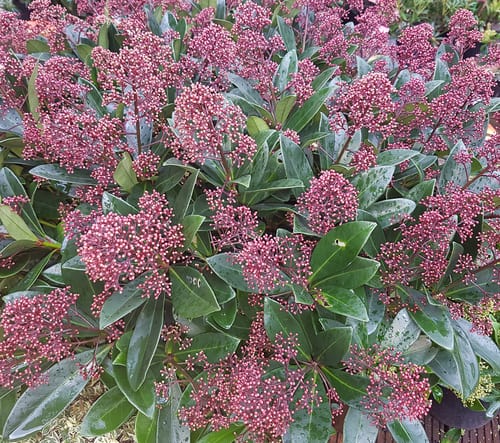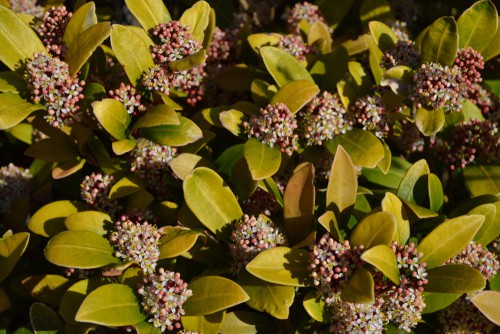Last updated on April 26th, 2022
Our site is reader supported, this means we may earn a small commission from Amazon and other affiliates when you buy through links on our site.
Skimmias are evergreen shrubs that reach about one metre in height and spread once they are fully established. They are often grown for their stunning foliage and if you have a male and female plant growing together then you can enjoy stunning berries from the female plant, which makes them particularly good for providing winter interest.
Growing Skimmia Shrubs
Before you plant one of these shrubs you need to make sure that you have the appropriate garden conditions that it requires, with the soil type being one of the most important factors, which we talk about in further detail below.
Plant in semi-shaded locations where possible
Firstly, this shrub needs semi-shade throughout the entire year, although in some circumstances they can tolerate full shade. If you have very low light levels they will become quite leggy, but they won’t die. They naturally exist in forests where low light is quite common. If you have an area in your garden where you plan to grow the shrub and it has full sun, it will easily burn the leaves, which is why open sunny sites are best avoided.
Skimmias are ideal for planting in the ground, growing in containers, or creating a small hedge
They need to grow either in the ground or in a container that is able to accommodate their mature size of at least one metre in height and spread. If you want to grow them as a hedge you need to make sure you plant them at least 45cm apart so that you can create a good thick hedge.
Plant them in slightly acidic soil or ericaceous compost if you are growing them in pots
They prefer slightly acidic soil, although they can also tolerate neutral soil. If you have alkaline soil, you will need to modify it every year in order to accommodate these plants.

They are very tolerant of drought, especially if they’re not grown in containers but directly in the ground because their leaves maintain moisture, so if you have trouble with drought where you live planting these shrubs might work out quite well. They will, however, need plenty of water until established but after this, they are generally okay when left to their own devices if grown in the ground.
Perfect for the less green-fingered of us
They do tolerate a great deal of neglect, so if you’re the type of gardener who likes to forget about your plants this is a great option. They grow very well without any pruning and they have a very low nutrient requirement. From November onwards they produce flower buds, these provide plenty of winter interest and they open into flowers between March and April.
Again if you have a male and a female plant together they will eventually produce red berries, however, if you have just a male plant on its own or just a female plant on its own they won’t. Do not eat these berries, however, because ingesting any part of this shrub can cause discomfort if you eat it, including the berries so be sure to leave them for the birds.
Different varieties to choose from

In the UK the most common variety is the Skimmia japonica. It’s a very shrub and it produces flowers that grow quite freely. There are a few other varieties you can find in the UK though including Skimmia Rubella (also very popular), Skimmia Fragrans, and Skimmia Nymans which is a Japanese female Skimmia that will produce red berries if planted with a male Skimmia such as ‘Kew Green’, ‘Rubella’ or ‘Fragrans’.

Skimmia Rubella has deep green leaves that are quite leathery and it produces purple and red flower buds that open into small white flowers.
Skimmia Fragrans have light pink and green flower buds but is otherwise the same.
How to care for your Skimmia
Once you decide on the variety you want, they all require the same level of care, and thankfully that level of care is quite minimal. As mentioned they can withstand a great deal of neglect given that their natural habitat is alone, isolated in the forest.

Test the soil to ensure is slightly acidic and improve if needed
In terms of soil, they do best with slightly acidic soil and if you are unsure what type of soil you have it is recommended that you get an at-home testing kit so that you can test the soil. If you have neutral soil you can always amend it ever so slightly so that it becomes slightly acidic. You can add things like sulphur to increase the acidity or mix in some ericaceous compost when planting.
Choose a semi-shaded position for the best results
Choose a location in your garden that gets semi-shade all year round if possible. Full shade, as mentioned will be fine as long as the plant is able to get natural light, however, it won’t perform as well.
Choosing a pot
If you want to grow it in a pot, make sure that you pick one that is well suited for its current size and pot up every couple of years as the plant reaches maturity. A plain terracotta is best because of the colour contrast with the foliage, however, it’s not a requirement and it is all down to personal preference.
Choosing the right compost
Make sure you fill the pot with ericaceous compost and check the acidity in the soil. Ericaceous compost is sold at most garden centres and nurseries.
No products found.
Feed them with an ericaceous feed
Feed your Skimmia with ericaceous plant food in March and August and make sure it’s properly watered when conditions get quite dry, especially if you are growing yours in pots. In the ground, they don’t require much care once they have established themselves.
When it comes to watering your Skimmia, rainwater is better than tap water because most tap water in the UK is too alkaline and these plants (as mentioned) prefer acidic conditions and that includes acidic water. A good solution is to collect and store rainwater using a water butt.
See our recommended water butts in this review we have written
Winter protection
These plants are quite frost hardy and they will survive even the strongest of UK winters when grown in pots. It is, however, best that you move them next to your house from November through February so that they get a little bit more protection against the cold and the wind to prevent the foliage from getting burnt.
Pests and diseases

Skimmia is generally not affected much by pests or diseases but they have been known to be attacked by spider mites. This is something that is best ignored because it won’t usually cause them any significant harm. However, if you feel the need to, you may want to spray them with a pesticide but this is often not needed.
The only other pests to watch out for are snails because they will leave holes in the leaves. As with all plants, the best way to combat this is to use slug traps or slug pellets but we like to try and keep things organic so would always opt for slug traps first.
Yellowing of the leaves

The problem you are much more likely to have is a magnesium deficiency and this causes the leaves to turn yellow. This happens because of the soil conditions and can be easily amended by simply adding epsom salt to the ground and you usually see the effects within a couple of months.
One final reason is simply a nutrient deficiency caused by the soil being too alkaline. This is also an easy fix and can be treated by simply adding ericaceous compost to the soil or topping up pots and then giving them a feed with an ericaceous feed.
Last update on 2024-07-27 / Affiliate links / Images from Amazon Product Advertising API








